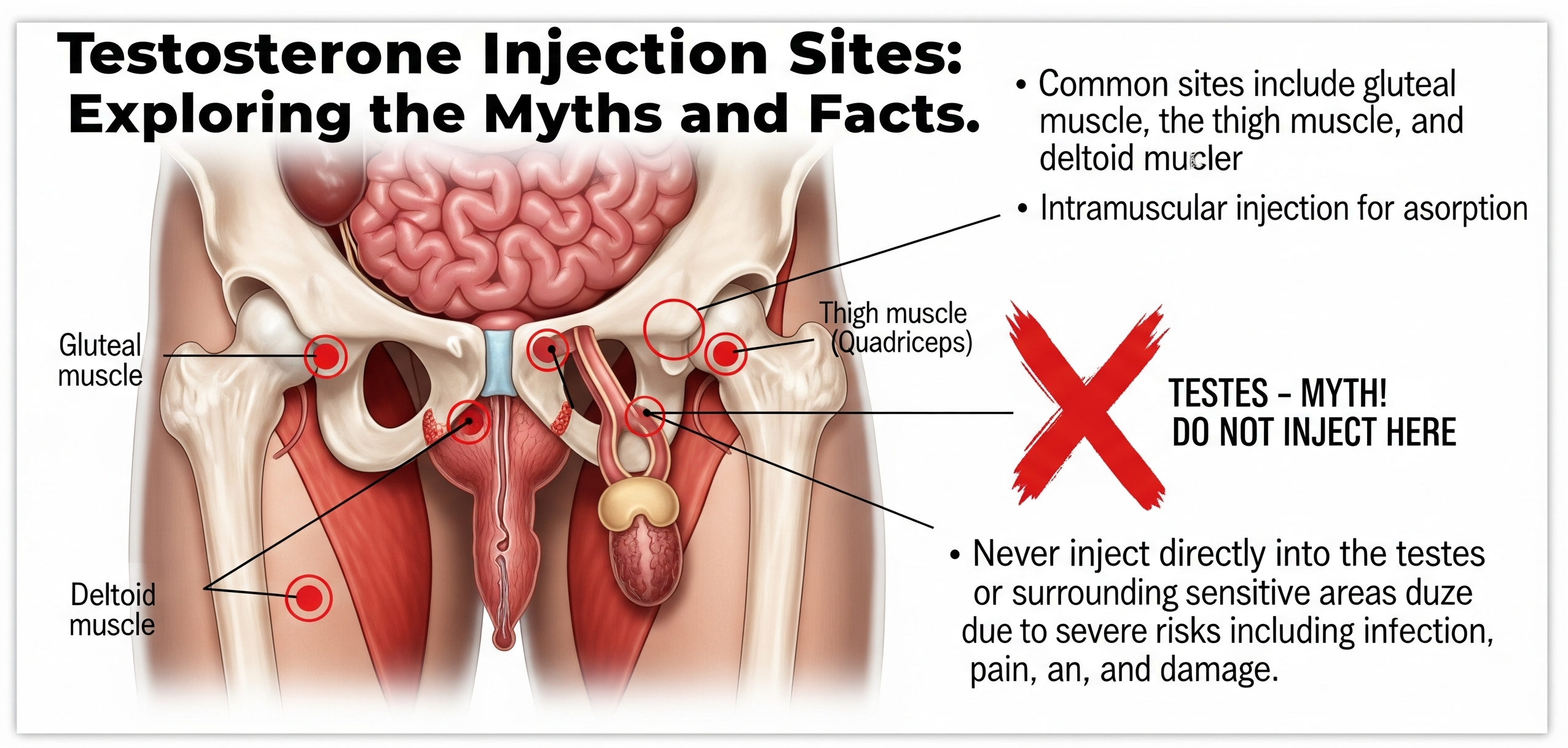When it comes to testosterone replacement therapy (TRT), one question that often arises is, “Can you inject testosterone in your balls?”
This query highlights the importance of understanding the proper injection sites for testosterone and dispelling any myths or misconceptions surrounding the topic.
In this article, we’ll explore the facts about testosterone injection sites and answer the question, “Can you inject testosterone in your balls?” along with other frequently asked questions.
Understanding Testosterone Replacement Therapy
Before delving into the question, “Can you inject testosterone in your balls?” let’s briefly discuss what testosterone replacement therapy (TRT) entails. TRT is a medical treatment designed to help men with low testosterone levels, or hypogonadism, restore their testosterone to a healthy range. Testosterone is a vital male hormone that plays a crucial role in various bodily functions, including:
- Muscle growth and maintenance
- Bone density
- Sex drive and sexual function
- Mood and cognitive function
- Red blood cell production
When testosterone levels fall below the normal range, men may experience symptoms such as fatigue, decreased libido, erectile dysfunction, reduced muscle mass, and mood changes. TRT aims to alleviate these symptoms by supplementing the body with exogenous testosterone.
Testosterone Injection Sites: Where Can You Inject?
Now, let’s address the question at hand: “Can you inject testosterone in your balls?” The short answer is no, you should not inject testosterone directly into your testicles. The proper injection sites for testosterone are intramuscular, meaning the hormone is delivered into the muscle tissue. The most common injection sites for testosterone include:
Thigh:
The vastus lateralis muscle, located on the outer mid-thigh, is a popular injection site for testosterone.
Buttocks:
The gluteal muscles, particularly the upper outer quadrant of the buttocks, are another common site for testosterone injections.
Shoulder:
The deltoid muscle in the upper arm can also be used for testosterone injections, although this site is less frequently used compared to the thigh and buttocks.
It’s crucial to rotate injection sites to minimize the risk of scar tissue buildup and ensure proper absorption of the hormone. Your healthcare provider will teach you the proper injection technique and help you identify the most suitable injection sites for your individual needs.
Why You Should Not Inject Testosterone in Your Balls
Injecting testosterone directly into the testicles is not only incorrect but also potentially dangerous. Here are a few reasons why you should never attempt to inject testosterone in your balls:
Testicles are not designed for injections:
The testicles are highly sensitive organs that are not structured to receive intramuscular injections. Attempting to inject testosterone into the testicles can cause severe pain, inflammation, and damage to the delicate testicular tissue.
Risk of infection:
Injecting testosterone into the testicles can introduce bacteria and other pathogens into the area, increasing the risk of infection. Testicular infections can lead to serious complications, such as abscesses or orchitis (inflammation of the testicles).
Impaired testosterone production:
The testicles are responsible for producing natural testosterone. Injecting exogenous testosterone directly into the testicles can disrupt the natural production process and potentially lead to further hormonal imbalances.
Ineffective delivery:
Testosterone injected into the testicles would not be effectively absorbed and distributed throughout the body, rendering the treatment ineffective.
It’s essential to follow the guidance of your healthcare provider and only inject testosterone into the recommended intramuscular sites to ensure the safety and efficacy of your TRT treatment.
Frequently Asked Questions (FAQ)
How often should you inject testosterone?
The frequency of testosterone injections depends on the specific formulation and your individual treatment plan. Common injection schedules include:
- Weekly injections: Typically, 100–200 mg of testosterone cypionate or enanthate is administered once per week.
- Bi-weekly injections: Some men may inject a lower dose of testosterone, such as 50–100 mg, every two weeks.
- Daily or every other day injections: Testosterone propionate, a shorter-acting ester, may be injected more frequently, such as daily or every other day, at lower doses.
Your healthcare provider will determine the most appropriate injection schedule based on your specific needs and response to treatment.
Can you inject testosterone subcutaneously?
While intramuscular injections are the most common method for administering testosterone, subcutaneous injections (injections into the fatty tissue beneath the skin) have gained some popularity in recent years. Some studies suggest that subcutaneous testosterone injections may be a viable alternative to intramuscular injections, offering similar effectiveness and potentially fewer side effects. However, more research is needed to establish the long-term safety and efficacy of subcutaneous testosterone injections. Always consult with your healthcare provider before considering any alternative injection methods.
What are the side effects of testosterone injections?
Testosterone injections, like any medical treatment, can cause potential side effects. Some common side effects include:
- Acne
- Oily skin
- Hair loss
- Sleep apnea
- Enlarged prostate
- Mood changes, such as increased aggression or irritability
More serious side effects, such as blood clots or liver damage, are rare but can occur. Your healthcare provider will monitor you closely for any adverse reactions and adjust your treatment plan as needed.
Can you self-inject testosterone?
Yes, most men on TRT learn to self-inject testosterone at home. Your healthcare provider will teach you the proper injection technique, including how to prepare the injection, locate the appropriate injection sites, and safely administer the medication. Self-injecting testosterone can be convenient and allow for greater flexibility in your treatment schedule. However, if you are uncomfortable with self-injection or have any concerns, discuss them with your healthcare provider.
How long does it take for testosterone injections to work?
The timeline for experiencing the benefits of testosterone injections can vary from person to person. Some men may notice improvements in their symptoms within the first few weeks of treatment, while others may take several months to see the full effects. Generally, most men report significant improvements in energy levels, libido, and mood within the first 3–6 months of consistent testosterone injections. Changes in body composition, such as increased muscle mass and reduced body fat, may take longer to become apparent, typically 6–12 months or more.
Key Takeaways
- You should never inject testosterone in your balls. The testicles are not designed for intramuscular injections, and attempting to do so can cause severe pain, infection, and hormonal imbalances.
- Testosterone injections should only be administered to the recommended intramuscular sites, such as the thigh, buttocks, or shoulder. Proper injection technique and site rotation are crucial for safety and effectiveness.
- The frequency of testosterone injections depends on the specific formulation and your individual treatment plan, ranging from daily to bi-weekly injections.
- Subcutaneous testosterone injections may be a viable alternative to intramuscular injections, but more research is needed to establish their long-term safety and efficacy.
- Testosterone injections can cause potential side effects, such as acne, oily skin, hair loss, and mood changes. Your healthcare provider will monitor you closely for any adverse reactions.
- Most men on TRT learn to self-inject testosterone at home, which can be convenient and flexible. Your healthcare provider will teach you the proper injection technique and safety measures.
- The timeline for experiencing the benefits of testosterone injections varies from person to person, but most men report significant improvements in energy levels, libido, and mood within the first 3-6 months of consistent treatment.
In conclusion, the answer to the question “Can you inject testosterone in your balls?” is a resounding no. Testosterone injections should only be administered into the recommended intramuscular sites, such as the thigh, buttocks, or shoulder, to ensure the safety and effectiveness of the treatment. If you are considering TRT or have any concerns about your injection technique, consult with a qualified healthcare provider who can guide you through the process and help you achieve optimal results.
References:
- Bhasin, S., Brito, J. P., Cunningham, G. R., Hayes, F. J., Hodis, H. N., Matsumoto, A. M.,… & Yialamas, M. A. (2018). Testosterone therapy in men with hypogonadism: An Endocrine Society clinical practice guideline. The Journal of Clinical Endocrinology & Metabolism, 103(5), 1715–1744.
- Kaminetsky, J., Jaffe, J. S., & Swerdloff, R. S. (2015). Pharmacokinetic profile of subcutaneous testosterone enanthate delivered via a novel, prefilled single-use autoinjector: A phase II study. Sexual Medicine, 3(4), 269–279.
- Spratt, D. I., Stewart, I. I., Savage, C., Craig, W., Spack, N. P., Chandler, D. W., … & Brengle, E. (2017). Subcutaneous injection of testosterone is an effective and preferred alternative to intramuscular injection in female-to-male transgender patients. The Journal of Clinical Endocrinology & Metabolism, 102(7), 2349–2355.
- Shoskes, J. J., Wilson, M. K., & Spinner, M. L. (2016). Pharmacology of testosterone replacement therapy preparations. Translational Andrology and Urology, 5(6), 834–843.
- Snyder, P. J., Bhasin, S., Cunningham, G. R., Matsumoto, A. M., Stephens-Shields, A. J., Cauley, J. A., … & Ellenberg, S. S. (2018). Lessons from the testosterone trials. Endocrine Reviews, 39(3), 369–386.





